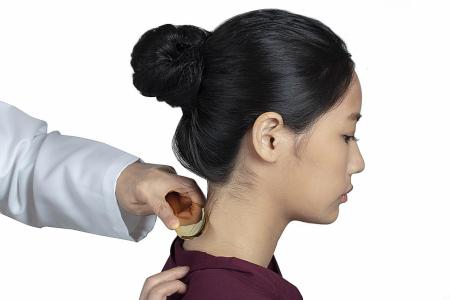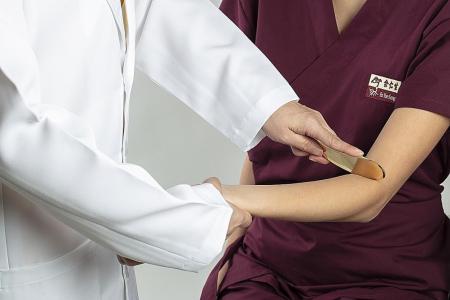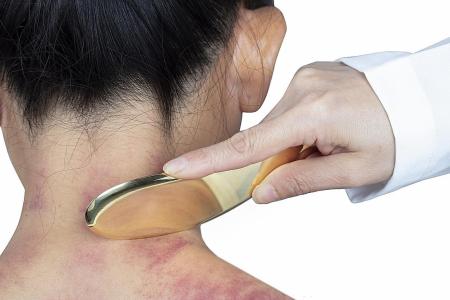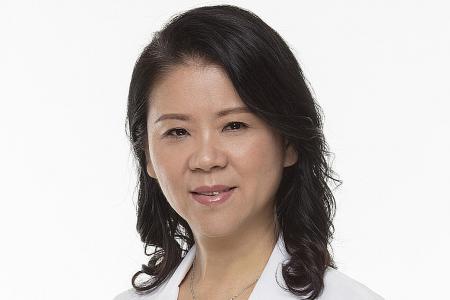Relieve pain and other medical conditions with TCM therapy gua sha
The natural therapy, based on TCM theory of meridians, can also help regulate body as a whole
Riddled with nagging pain in your body but afraid of acupuncture needles?
Relief may just come in the form of gua sha, a natural therapy based on the TCM (traditional Chinese medicine) theory of meridians.
During the treatment, the skin is lightly scraped using a scraping tool, producing a red bruise-like or rash-like appearance that usually fades within three to six days and is not a cause for concern.
It is usually performed on fleshy parts of the body, such as face, neck, shoulders, back and the four limbs.
According to physician Chen Yan Fang of Eu Yan Sang TCM Wellness Clinic at Royal Square at Novena and Eu Yan Sang TCM Clinic at Buangkok Square Mall, the benefits of gua sha include helping to "relieve tension and tightness, release blockage in the meridians, promote blood circulation and dispel toxins from the body, thereby preventing and treating various illnesses".
She said: "It is an alternative treatment in TCM for people who reject acupuncture or TCM herbs due to fear of needles or having poor medication compliance.
"After the treatment, petechiae (red or purple spots) will appear on the skin and one may feel pain or a slight burning sensation."
What ailments does gua sha treat and how effective is it compared with Western treatments that target bodily pain?
Apart from acute chronic diseases, gua sha is suitable for treating a variety of conditions including general pain (neck, shoulder, back, leg), fever, colds, headache, asthma, insomnia, facial paralysis, asthma, menstrual pain, irregular periods, amenorrhea (the absence of menstruation), acne, chloasma (skin discoloration), hives, tinnitus and loss of hearing.
The response to gua sha varies - some find it more effective when combined with other TCM treatments like herbs, acupuncture and cupping.
Western medicine can manage pain within a shorter period of time. This is useful for people who are suffering from major pain which could possibly affect their movement.
But once the effect of the medicine/treatment wears off, the pain might come back. Larger doses of medicine or even surgery may be required subsequently.
On the other hand, TCM treats patients as a whole instead of the pain/disease itself.
We believe that pain is caused by the obstruction or deficiency of qi and blood.
Other than improving the localised blood circulation, gua sha can also help to regulate the body condition as a whole, thereby preventing patients from getting pain relapse.
Is gua sha safe for everyone?
It is, except for people with the presence of edema due to cardiovascular diseases or liver failure, those with a clotting disorder, infectious skin disease, areas with infections or wounds.
People who are unable to cooperate with the treatment, like alcoholics, schizophrenia patients and those prone to seizures, and women who are on their period or pregnant, are also not suited to it.
Being non-invasive and relatively pain-free, it works for people of all ages - children, adults and the elderly.
Are there any popular misconceptions about gua sha that you would like to debunk?
One of them is how gua sha causes bodily injuries.
The bruises that appear after gua sha treatment are due to red blood cells gathering at the surface tissue. Gua sha can help to improve local microcirculation instead of damaging body tissues. It is generally safe when performed by a professional TCM physician.
Gua sha is not supposed to be painful, but as the treatment deliberately causes tiny blood vessels to burst and therefore cause bruising, this may cause discomfort for some.
Physicians will generally apply less force when dealing with elderly patients or those who have weak body constitution.
The gua sha tool is readily available online and in the market. How safe is it for people to perform the therapy on themselves or others?
There are online tutorials, but it would be safer for gua sha to be done by licensed TCM physicians.
They are able to diagnose a patient's condition and determine if the patient is suitable for gua sha, how much force to apply, and how long the treatment duration and follow-up should be.
Get The New Paper on your phone with the free TNP app. Download from the Apple App Store or Google Play Store now





